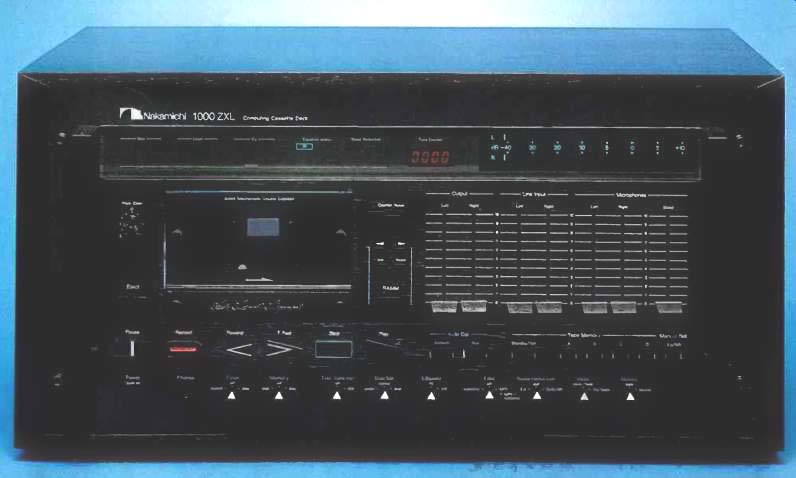
Manufacturer's Specifications:
Frequency Response: 20 Hz to 20 kHz, ±0.75 dB, with Nakamichi tapes.
Harmonic Distortion: 0.8 percent at Dolby level with 400 Hz.
Signal/Noise Ratio: 66 dB with Dolby NR.
Separation: 37 dB.
Crosstalk: 60 dB.
Erasure: 60 dB.
Input Sensitivity: Mike, 0.2 mV; line.
50 mV; external NR, 100 mV.
Output Level: Line, 1.0 V; external NR, 100 mV; headphones, 45 mW.
Flutter: 0.04 percent W rms, 0.08 per cent wtd. peak.
Dimensions: 20 3/4 in. (527 mm) W x 10-3/16 in. (258 mm) H x 12-11/16 in. (322 mm) D.
Weight: 41.9 lbs. (19 kg).
Price: $3,800.00.
Immediately, the Nakamichi 1000 ZXL computing cassette deck is most impressive: The physical size and weight, the features included, the specified performance, and the price. The unit is supplied in a rugged wooden cabinet, and it is rack-mountable if that is desired. The front panel is the standard Nakamichi black with white lettering, which is easy to read even in fairly dim light. Behind a clear cover along the top of the deck are the display panel for A.B.L.E. and RAMM, the 4-digit electronic counter, and the fluorescent level indicators. The acronym A.B.L.E. stands for the microprocessor-controlled Azimuth, Bias, Level and Equalization adjustment system which automatically adjusts any and all of these parameters for best performance with the tape being used. RAMM (Random Access Music Memory) allows location/identification of up to 15 separate pro grams on a tape and putting up to 30 commands for playing programs in memory. The displays for these functions are groups of bright annunciators that are very easy to read. The A.B.L.E. row is on top, that for RAMM is just below. These functions and their displays will be covered in more detail in the "Circuit Description" section of this report.
The fourth digit of the tape counter provides increased resolution of tape position at the beginning of the cassette. The red digits were a bit dim, however, causing reading difficulty with medium to bright room lighting. The fluorescent level meters, on the other hand, appear to have exactly the right brightness for all lighting conditions. The 56-segment bar graph, with individual thresholds, provides the best resolution for such devices seen to date. The scale is expanded (smaller dB steps) between "-10" and "+10" which increases its value to the recordist. Below are the slider-type input and output level controls. There are separate line and microphone faders (pots, if you prefer), so it is a simple matter to mix as desired. There is also the exclusive Nakamichi Blend mike input, which is fed equally to both channels at the same time that the other two mike inputs are used as desired. It is an appealing feature which gives the recordist much more flexibility on mike placement and the resultant sound. The sliders are positioned in pairs so that the left and right knobs in any set are easily held simultaneously for smooth fading of both channels at the same time. The RAMM controls are to the left of the faders, and those for A.B.L.E. are below--more about these later.
The logic-controlled, light-touch transport switches are unusual in several respects. First of all, they are larger than most, with plenty of area for a finger to push. They are also coded by shape and color. Stop and Pause (with an added white vertical bar) are rectangular with status indicators that are actually light-green surrounds. Play, Rewind and F.Fwd are good-size arrow shapes, with similar surround-type light-green status indicators.
The wind buttons also have white arrows on the button faces. Record is oval shaped with a red bar in the center and a red surround-type status indicator. There is no doubt about their being different from most transport switches, and their status can be seen from anywhere in the room, a feature of possible value to some users. A second push of Record obtains muting while held in. The logic system does not permit making flying start recordings, consistent with other Nakamichi decks, which is a possible limitation for some users. A pitch control, with center detent, provides ±6 percent adjustment in tape play speed; it is not operational in the record mode to prevent making unwanted errors. Eject obtained a smooth opening and tilting of the cassette carrier. Loading was smooth, and access was excellent for maintenance tasks. Pushing Pause when in fast wind obtains cue mode with the play head moved closer to the tape and wind speed reduced to one-third. Holding a wind button at that point reduces the speed to one-fifth of normal. Rocking the tape is possible with the two wind buttons. All in all, this is an excellent cue system.
Along the bottom of the front panel are the power switch, the headphones jack, and nine rotary switches with pointer knobs. They provide selections for Timer (record/off/play), Memory (stop/off/play), Test Tone (off/400 Hz), Bias Set (under/nor mal/over), EQ (70/120 µS), Filter (subsonic/off/MPX/MPX & subsonic), Noise Reduction (external/out/Dolby NR), Meter (peak/hold, VU/peak), and Monitor (tape/source). Most of the designations are self-explanatory, but some added comments are in order. Bias Set allows shifting the normal range of bias used by A.B.L.E. up or down 12.5 percent for tapes with un usual bias needs or special recording needs. The 400-Hz test tone is for calibrating other equipment for use with the 1000 ZXL, in particular a Nakamichi High Corn II system. Thus, there is an Ext. position on the noise-reduction switch for this or other NR systems. In Peak/Hold mode, the meters are peak responding, and there is an additional cursor which indicates peaks and then decays at a rate that is 10 times slower than the peak--meter indication, effectively holding the peak for some time, but not for an extended period. In VU/Peak, the meters have VU ballistics, but the cursor is peak responding. This is a desirable combination at times, for it gives continual indication of both averaged and peak levels.
On the back panel are stereo sets of line-in/line-out jacks as well as encoder in/out and decoder in/out jacks for external noise-reduction systems, with all jacks gold-plated--a good way to improve the reliability of such connections. There are also sockets for mechanism and RAMM remote controls as well as a holder for the batteries used to keep the A.B.L.E. memories alive when a.c. power is off. The final item is a ground post.
The 1000 ZXL was carefully removed from its cabinet for a look at the construction. Everything appeared to be of high quality, and the soldering on the many p.c. boards was excellent, with very little flux residue. Interconnections were mostly multi-pin with some wirewrap. Parts and adjustments were labeled on both sides of the cards, and five soldered-in fuses were noted.
Shielding was used around some circuits, with the fluorescent display and its drivers completely enclosed. This high-quality design and construction help prevent switching noises from get ting into the audio.

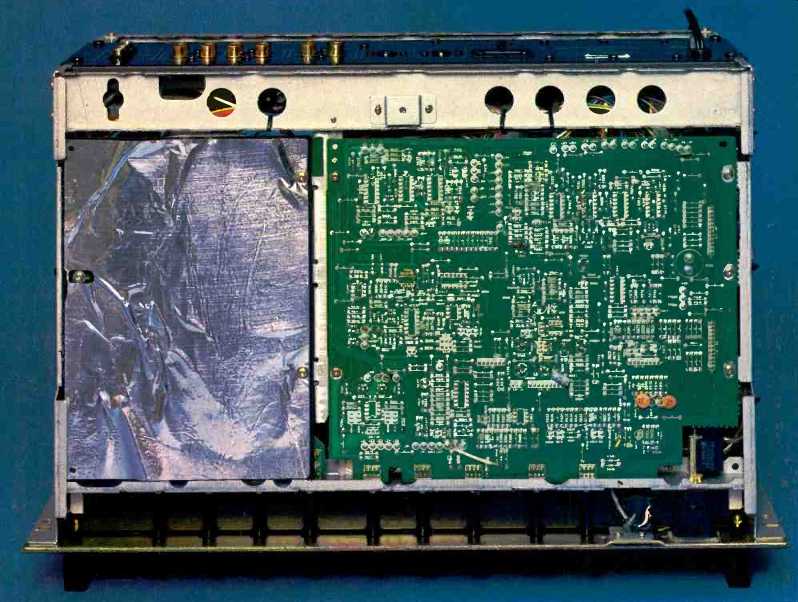
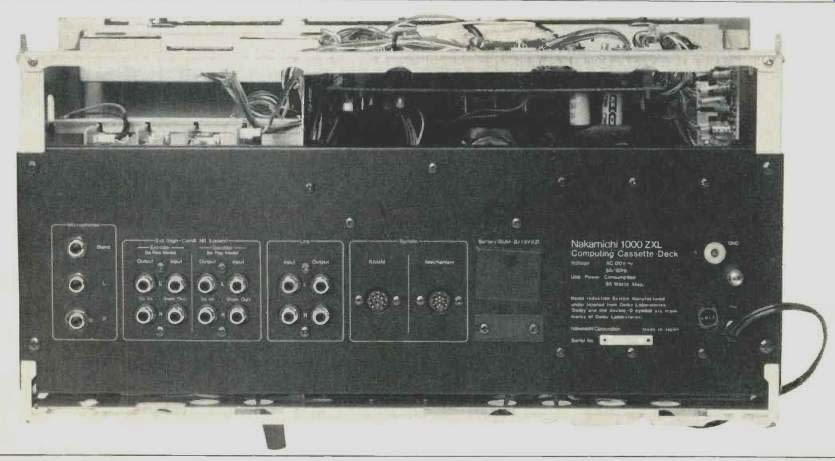
Circuit Description
Figure 1 is a block diagram of one channel of the 1000 ZXL. A perusal of the elements shown will demonstrate why Nakamichi classifies the unit as a "computing" cassette deck. There are the RAMM and auto calibration computer processing units and A/D, D/A converters. Some of the circuitry shown is standard for all three-head decks, so space will not be taken to follow such signal paths.
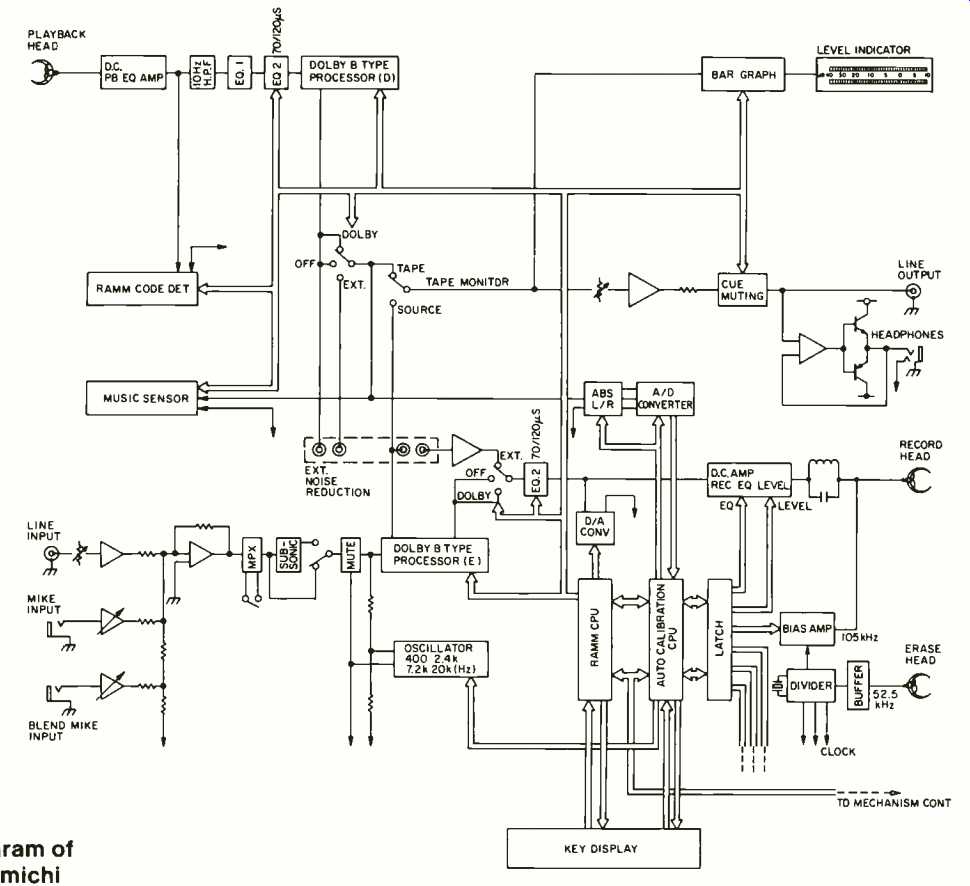
Fig. 1-Block diagram of one channel, Nakamichi 1000 ZXL cassette deck.
As Nakamichi states in their literature, this unit is the first tape recorder with a specified response of 20 Hz to 20 kHz, ± 0.75 dB, which does raise more than a few eyebrows. The microprocessor-controlled A.B.L.E. auto calibration scheme includes azimuth alignment of the record head, adjustment of bias current and recording equalization, and setting record sensitivity for level matching and best Dolby tracking. Initiating the process is most simple: From Record/Pause to Record, push Play while holding the auto cal Run button. The first step is azimuth alignment of the record head, and a flashing indicator shows that alignment is in process. Next, bias is adjusted and annunciators flash on and off from channel to channel. EQ is next and then level, with some final trimming back and forth between these two. Note in the figure that the oscillator has frequencies of 400 Hz and 2.4, 7.2, and 20 kHz. This is part of the sophistication that obtains the outstanding response, as the adjustments are made to meet criteria at all four points. There is a latch function, of course, for all of the adjustments, and when they are complete as shown by the annunciators, the information on all of the adjustments can be put into any one of four memories. Playback EQ and noise-reduction mode can also be stored at the same time. Once the calibration has been stored for a particular formulation, it will probably only be necessary to touch up azimuth alignment with the Azimuth auto cal button and then punch in the appropriate tape memory. If you change your mind on EQ or NR, there is an EQ/NR Manual Set for such a purpose. It is of some interest to note that bias to the erase head is at one-half the frequency of bias to the record head. The lower frequency, which is frequency and phase locked, gains greater efficiency in erasing, while the 105 kHz to the record head minimizes bias birdies.
Because RAMM is microprocessor controlled, some functions are possible that are outside the capability of other systems for similar purposes. As many as 15 separate programs or selections can be identified by RAMM, and up to 30 commands can be stored for any order of playing, repeating any as desired. The RAMM encoding uses a sub-audible (5-Hz) frequency which can be inserted anywhere on a tape. Normally, that would be in a silent space of 2 to 4.5 seconds, but it can even be in the middle of a selection. Encoding can be either automatic or manual, and annunciators continually show the status of that process or the decoding when there is playback of an encoded tape. The encoding/decoding not only gives the location of each of the programs, but the EQ and NR settings used to make the recording will be matched for proper playback even if the panel switches are set differently. To keep the 5-Hz RAMM signals out of the audio signal in playback, there is a 10-Hz high-pass filter after the d.c. playback equalization amplifier. The subsonic recording filter is used to keep out such things as record-warp/arm-resonance effects which could introduce spurious signals into the encoding. There is a push-button switch to enter the RAMM mode and set, reset, up, and down switches to do the encoding.
Performance
The playback response with standard alignment tapes was well within 2 dB at all points, usually within a fraction of a dB. Level indications on the meters were about 0.5 dB high. Tape play speed was 0.5 percent fast. The deck was supplied with Nakamichi EXIT, SX and ZX tapes, and the great majority of the tests were run with them. To give a fast check to the auto calibration system, many tapes were run through the calibration cycle, and then the record/playback response was checked with pink noise and a 1/3-octave RTA. All results were at least very good--usually excellent, including operation in Dolby mode. The average time to do the complete auto calibration was about 40 seconds, with azimuth alignment in only 10 seconds or less.
Nakamichi EXII was put through auto cal, and the results were stored in Tape Memory A. SX and ZX tapes were put through the same process, and the results were stored in memories B and C, respectively. Memory D was retained for use in any crosschecks to be made. Record/playback responses were taken at Dolby level and at 20 dB below that, both with and without Dolby NR. The plotted responses appear in Figs. 2 to 4, and the -3 dB response limits are listed in Table I. The EXII plots (Fig. 2) show the poorer of the two channels, and the center-frequency rise with the other channel was limited to 0.7 dB. The Dolby tracking with the SX and ZX tapes is superb. Outside of the subdued peak at 20 kHz with SX tape, all responses at -20 dB without NR were within ±0.75 dB from about 17 Hz to 22 kHz.
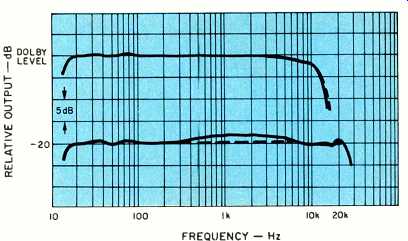
Fig. 2-Frequency response with and without (----) Dolby NR using Nakamichi
EXII tape.
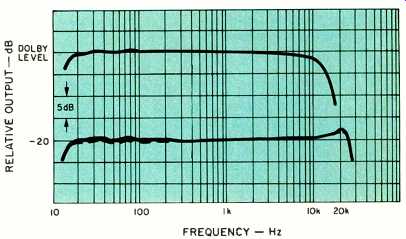
Fig. 3-Frequency response with and without (----) Dolby NR using Nakamichi
SX tape.
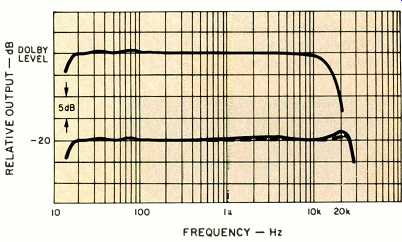
Fig. 4-Frequency response with and without (----) Dolby NR using Nakamichi
ZX tape.
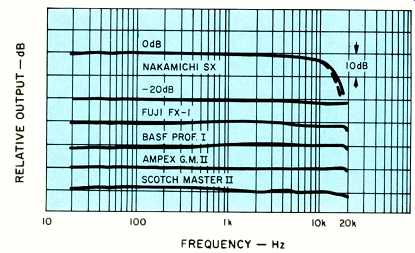
Fig. 5-Frequency responses of various tapes in Dolby mode with auto calibration.
Nakamichi SX tape shows effects of under and over (----) bias settings; all
other tapes with normal bias setting.
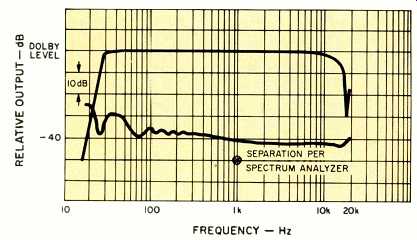
Fig. 6-Frequency response of subsonic and MPX filters and interchannel record/playback
separation with 20-Hz to 20-khz sweep at Dolby level.
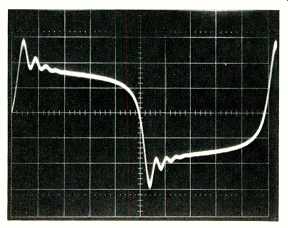
Fig. 7-Record/ playback of 1-kHz square wave.
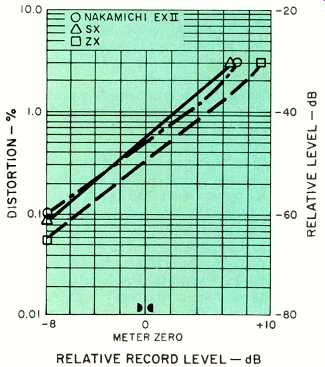
Fig. 8-Third harmonic distortion vs. level in Dolby mode at 1 kHz with Nakamichi
EXII, SX, and ZX tapes.
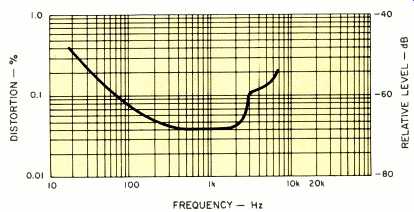
Fig. 9-Third harmonic distortion vs. frequency in Dolby mode at 10 dB below Dolby level with Nakamichi ZX tape.
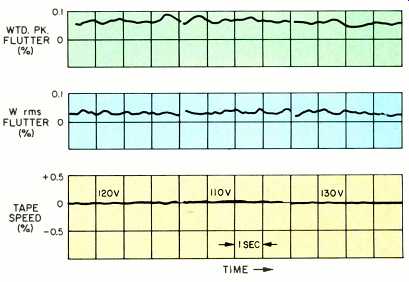
Fig. 10-Tape play speed vs. time and line voltage, and wtd. rms and wtd. peak
flutter (three trials each).
At this same level, the -3 dB points were at 13 Hz and 26 to 27 kHz for all tapes. The responses at 0 dB are also very impressive, not only for the extended headroom but for the flatness of the responses before roll-off. These are the best responses to date--bar none. Fig. 5 shows what might happen if the bias set switch was moved to "under" or "over." Actually, the computer system made them both good, with just a very slight difference at 0 dB. The figure also has the-20 dB responses of a number of tapes selected at random to put through A.B.L.E. All deviations are within about 1 .5 dB in Dolby mode as shown; responses without NR were measurably flatter.
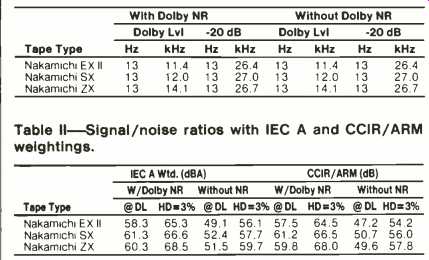
(top) Table I--Record/playback responses (-3 dB limits). (above) Table II--Signal/noise
ratios with IEC A and CCIR/ARM weightings.
Figure 6 is a plot of the frequency response of the subsonic and multiplex filters. The attenuation at 20 Hz seems excessive, but this roll-off may be necessary to ensure reliable operation of the RAMM system in case of record warps, etc. The record/ playback separation from one channel to the other is also plot ted. This must be considered as an "at-least" plotting because a spectrum analyzer check at 1 kHz gave a significantly lower figure. The auto azimuth alignment consistently positioned the record head so that the playback of a recorded 10-kHz tone had 90 degrees phase difference between channels. A check at lower frequencies showed that the interchannel time error was consistently 25 to 35 µS. This alignment error is not large, but it seems that the alignment system should have done better.
Phase jitter of the 10-kHz tone was just 15 degrees, less than most decks. Bias in the output was exceedingly low. Figure 7 is the playback of a 1-kHz square wave, notable for its good shape and steadiness. The output in Tape was the same polarity as the input, but the polarity was reversed in Source. The 400-Hz (396-Hz actual) test tone gave a 0-dB indication on the meters and had 0.7 percent distortion, plenty good enough.
With the use of a spectrum analyzer and a 1-kHz test tone, the measured channel separation was 50 dB and cross talk was down at least 72 dB, both excellent figures. Erasure was checked at 100 Hz with ZX metal tape. The resultant figure of 74 dB supports the manufacturer's claim of superior erase head design. Attention was then given to checking the level of third harmonic distortion (HDL3) vs. record level from -8 dB re: Dolby level up to the point where the distortion reached 3 percent. Examination of this figure and comparison with other data taken in the past will prove how excellent these results are, particularly for metal tape. All too many recorders are touted as metal-tape compatible but have very high distortion with that formulation. Data were obtained on HDL3 vs. frequency (Fig. 9) with ZX tape in Dolby mode at -10 dB, and because of tape noise, getting valid figures was a bit of a challenge from 400 Hz to 1 kHz, where the distortion level was just 0.040 percent. The distortion was also comparatively low at the frequency extremes.
Other harmonics were low in all cases, especially so with ZX tape. Without Dolby NR, distortion figures were up to 30 percent higher in the mid frequencies.
The signal-to-noise ratios were measured for the three tapes with both IEC A and CCIR/ARM weightings, with and without Dolby NR. The results listed in Table II were based upon measurements of playback with the 1-kHz test tone recorded at both Dolby level and the point at which HDL3 = 3 percent. The results are excellent, and the good utilization of tape capabilities is indicated with the increasing values from Type I to Type II to Type IV formulations.
The input sensitivities were 0.18 mV for left and right mikes, 0.22 mV for the blend mike, and 55 mV for line. The input overloads were 30.4 V for line and an astounding 2.05 V for mike, by a wide margin the highest ever measured. The output clipped at a level equivalent to +17 dB re: meter zero. While being held at the same time with a thumb and index finger, the input-level pot tracked within a dB for about 40 dB--showing that well-balanced fades were very possible. The output-level pots gave similar results. The line outputs were 1.00 V at meter zero, dropping to 0.85 V with a 10-kilohm load. This result, consistent with the specified output impedance of 2 kilohms, should be no cause for concern in audiophile usage, but it's on the high side in studio use where there might be a few 10-kilohm loads in parallel. The headphone output was 0.62 V or 48 mW to 8 ohms. All phones tried could be driven to very high levels, easily controlled with the output faders. The dynamic response of the fluorescent meters was to standard with the VU setting. In peak mode, the attack time was to standard, but the 2.9-second result for 20-dB decay was on the high side. Frequency response was 3 dB down at 7 Hz and 30.4 kHz. The 56 segments in each bar graph provided excellent resolution, and they were very accurate from "-20" to "+10." At the lowest levels, readings were slightly high, more so in peak mode.
Tape speed appeared to increase slightly with line voltage reduced to 110 V during the plotting (Fig. 10), but the counter monitor of the 3,000 Hz increased only one digit, a minuscule increase. The flutter was quite consistent from trial to trial, and typical figures were outstanding: 0.03 percent wtd. rms and 0.06 percent wtd. peak. The wind times for a C-60 cassette averaged 48 seconds, fast and smooth. The tape-play speed control had a range from-6.4 to +7.1 percent, a bit over a semi-tone (5.9 percent) each way. All operations of the transport control/logic system took less than a second, including wind run-out to stop.
Use and Listening Tests
All in/out cassette handling and maintenance tasks were conveniently done and there was automatic tape-slack take-up, another nice feature. The slider-type level controls were a distinct pleasure to use, working smoothly and setting levels quickly. The rotary switches showed good detenting, and the pointer knobs facilitated fast checks of position. The surround-type indicators on the transport controls aided operation in dim lighting.
The purposeful attempts to cause some sort of hang-up caused no problems whatsoever with these or the switches for auto calibration and RAMM. Everything just kept working smoothly, with occasional "chiding" from the annunciators that I had made a mistake. The cueing facilities of this Nakamichi deck are unusual, and they were put to good use on a number of occasions. I did miss the lack of a flying-start scheme, but others may not notice. Pushing Record again to get muting seemed slightly odd in ways, but it certainly worked.
The level meters generated a fair amount of enthusiasm in use--their wide range, resolution, brightness, and the excellent implementation of both VU and peak-responding displays. I was continually impressed that the recorder could be turned on and off, that days could pass, and that the information in tape memory could still be called forth to ensure superb results. The instruction book has very good text and illustrations, with a number of helpful added footnotes. There is quite a bit on RAMM, which is good, because many such systems have inadequate explanation. There is no schematic, but there is a good block diagram--actually more useful to the audiophile.
In addition to a few pink noise checks of Dolby NR in/out effects, listening tests were conducted primarily with discs as source material. The music included the dbx-encoded Baroque Brass with the Empire Brass Quintet, The Organ at Chester Cathedral with Roger Fisher, and some of the Maxell sampler re cords. Everything sounded so good that there was a little confusion on the position of the monitor switch at times. With pink noise and vocals, it was possible to hear the slight boost in Dolby mode with EXII tape, but not at other times. ZX tape showed some of its superiority with triangle and finger cymbals in one selection. The sound of the organ's pedal range was particularly good with this Nakamichi deck. Record and stop clicks were in tape noise; pause sounds were not detected. There was an 8-second delay after timer start, into Play or Record as selected.
The Nakamichi 1000 ZXL computing cassette deck offers a level of performance unmatched by any other deck. The flatness of the frequency responses is superlative, the distortion is superbly low, the A.B.L.E. automatic calibration system is simple to use and amazingly accurate, flutter is very low, and there are many other attractive features of this most unusual deck. Nakamichi calls the 1000 ZXL "The Ultimate Recording Investment," and an excellent investment it can be.
-Howard A. Roberson
(Adapted from: Audio magazine, Jun. 1982 )
Also see:
Nakamichi 1000ZXL Limited Cassette Deck (Sept. 1982)
Nakamichi 680ZX Stereo Cassette Deck (Sept. 1980)
Nakamichi cassette decks (Dec. 1982)
Nakamichi Model 600 Stereo Cassette Console (Sept. 1976)
Nakamichi CR-4A Cassette Deck (Aug. 1988)
Nakamichi 1000 DAT Recording System (Nov. 1989)
= = = =